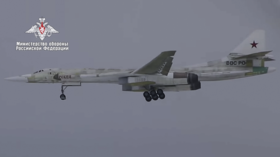Secretive Russian stealth fighter jet Su-57 to take part in Victory Day parade flyover (VIDEO)
Cutting-edge, fifth-gen Su-57 fighter jets have been spotted flying over Moscow during rehearsals for the upcoming Victory Day celebrations. RT spoke to one of Russia’s ace pilots to learn more about these secretive machines.
The large-scale celebrations that were set to mark the 75th anniversary of Soviet Russia’s World War Two victory over Nazi Germany were scrapped last month, due to the current coronavirus situation. The customary military parade in Moscow has been cut down to an aircraft flyover only, which will occur on May 9 if weather permits.
READ MORE: Buzzing where corona can’t get you: Watch Russian warplanes train for V-Day air show
On Monday, the Russian military staged a rehearsal of the flyover, with dozens of military aircraft appearing in the skies above the capital – among them, four Su-57 fighter jets.
The aircraft, which rarely appears in public, entered mass production last year. currently, the Russian military operates only pre-production planes, while mass-produced machines are expected to join the force later this year. The exact number of jets in service with the Russian Aerospace Forces is shrouded in mystery, though it is likely to be around a dozen.
A handful of nations, including Russia, China and the US, have fifth-generation fighters in stock, while only Washington enjoys a sizeable fleet of them. Still, the American F-35 planes often receive public attention not due to their outstanding performance, but because of the program’s ballooning costs and numerous technical issues plaguing the aircraft.
The troubled F-35 made headlines again recently, after the Pentagon decided not to fix critical issues with the C variant, instead reducing its supersonic flight capabilities. It transpired that the plane was designed in such a way that it risks damaging its tail section during prolonged supersonic flight. Fixing the issue would basically require a reworking of its entire airframe, and thus was deemed to be too costly.
Also on rt.com Why is it even called 5th generation? Pentagon's decision not to fix supersonic speed issue with F-35C defeats jet's very purposeThe F-35’s Russian counterpart has no such problems – and therefore no limitations on its performance, according to first-class Russian military pilot and deputy commander of the aerobatics group Strizhi (the Swifts) Vladlen Russanov, who was speaking with RT.
Unlike the F-35, he explained, the Su-57 is capable of reaching speeds twice as fast as the speed of sound without using an afterburner.
Su-57 has no limitations on combat use within its speed and altitude capabilities. That’s why we can say that Su-57 already outperforms F-35 in this aspect.
The afterburner is a component, present on many jet engines, that injects fuel into the jet pipe after the turbine, increasing thrust at a cost of very high fuel consumption. Thus, the Su-57 is way more fuel efficient than its US counterpart, and is capable of better performance without any need to put additional stress on the power plant.
Moreover, the Russian aircraft is significantly more agile than its US counterpart, the pilot said. The plane has proven to be capable of making truly physics-defying stunts, thanks to its state-of-the-art control system and well-designed airframe.
“F-35 has a single engine, while our plane has two. Moreover, while [F-35] has thrust vectoring it works only on a single axis, and Su-57 has two-axis thrust vectoring,” Russanov said.
Also on rt.com Watch Russian Su-57 fire missile during NEAR-VERTICAL CLIMB as pilots master new jet’s capabilities (VIDEO)Still, the times of close-range dogfights are long gone, and a plane’s agility is not as important as it used to be in the propeller aircraft era. The key to dominating the skies is the ability of an aircraft to see its enemy first, while keeping a low profile itself. The Russian Su-57 is likely to outperform the F-35 in that regard too, Russanov said, as it was built to possess excellent stealth capabilities.
Aircraft that utilize low-observable technology usually have sleek forms, with a small cross-section. They are covered with a special coating to make them less visible on an adversary’s radar. They also have their main weaponry hidden within an internal bay, to prevent any missiles from sticking out and making the machine easier to spot. Still, the moment a plane opens its weapon bay to attack, it becomes exposed to the enemy’s radar, to a certain extent.
Also on rt.com Russia's new 5gen supersonic stealth Su-57 fighter jets ace all objectives in Syria trials – Chief of StaffThe weapons bays of the Su-57 – which are likely more spacious than the ones of the F-35 – have been designed to keep the weapons deployment as sneaky as possible, Russanov said.
“We have a completely new launching system that puts a missile into the airflow. And we can say that this launching system is significantly less exposing,” Russanov explained.
Think your friends would be interested? Share this story!














